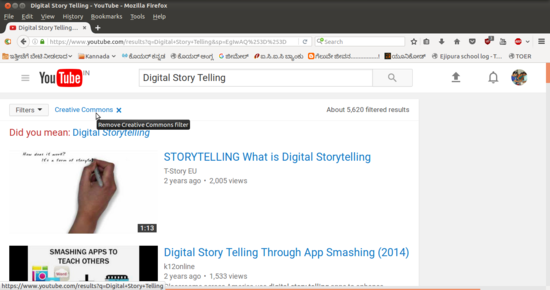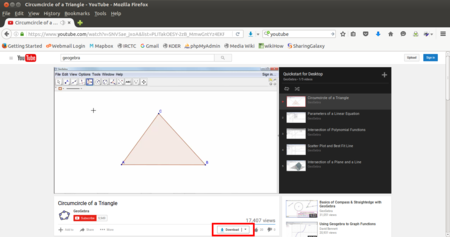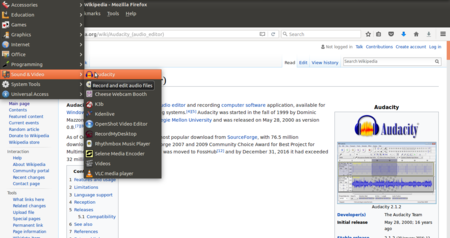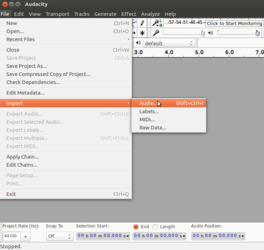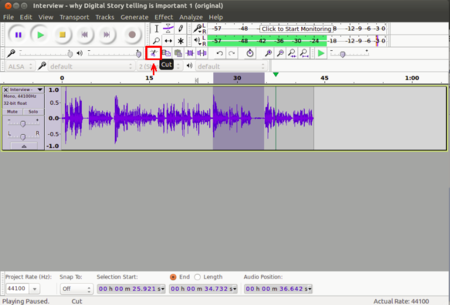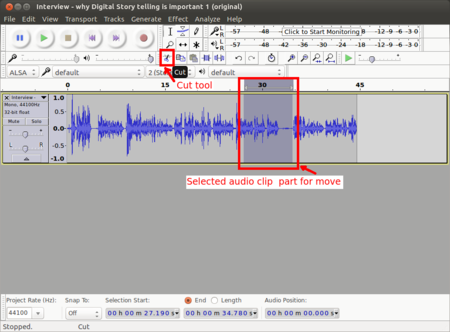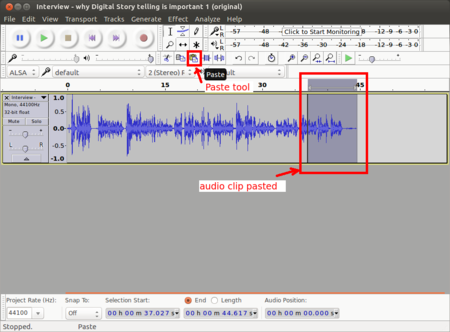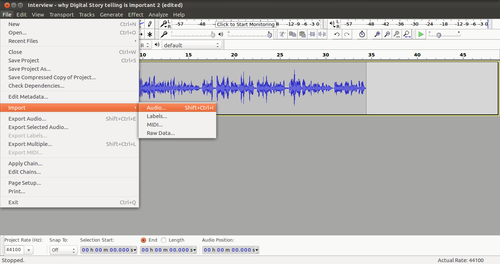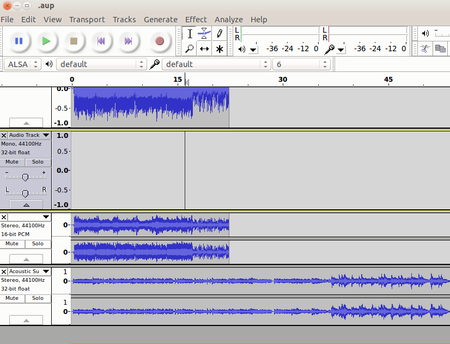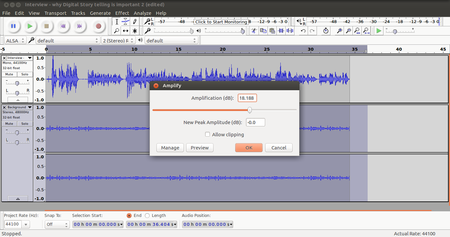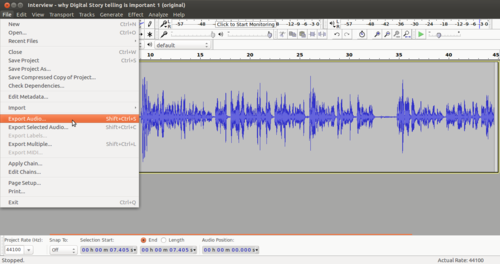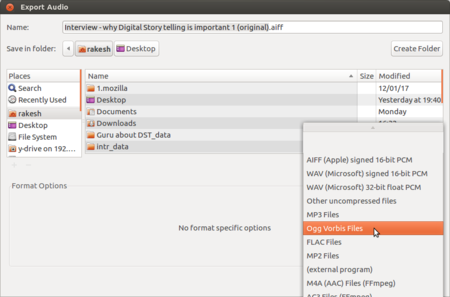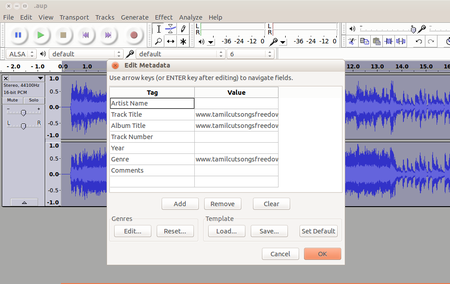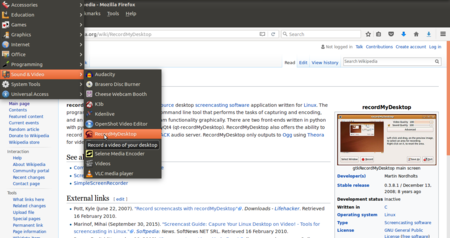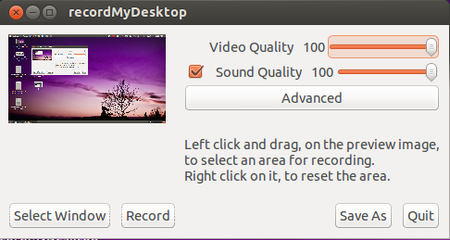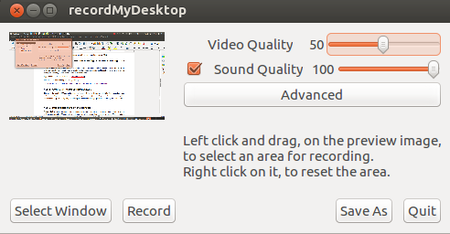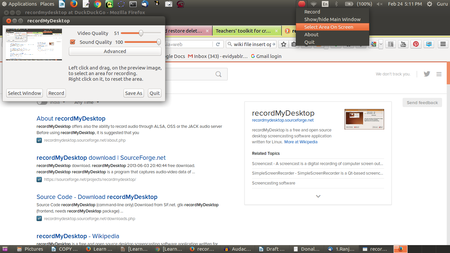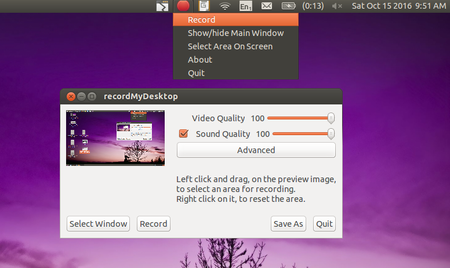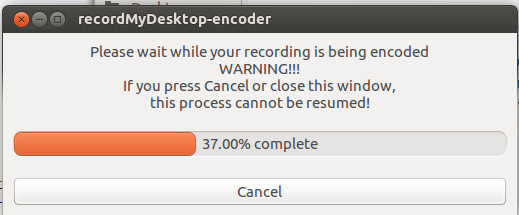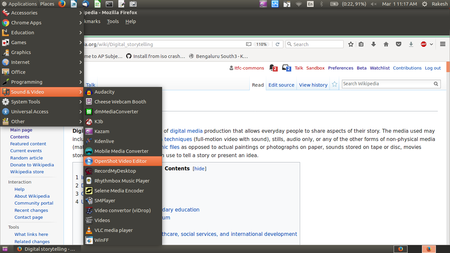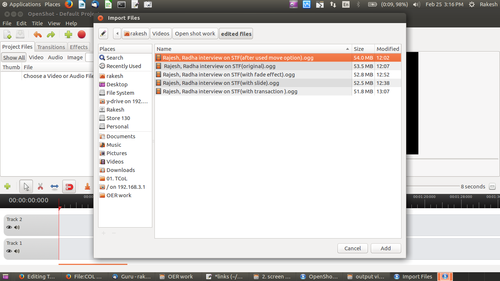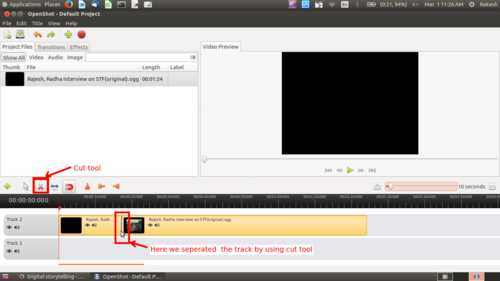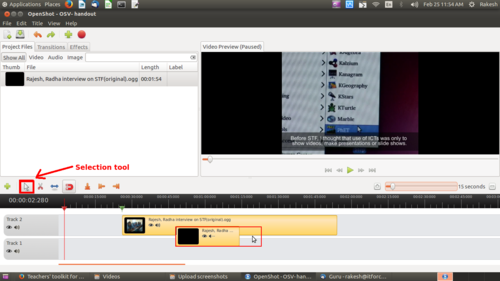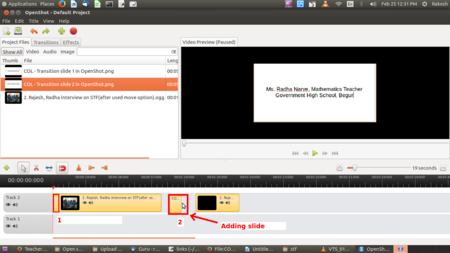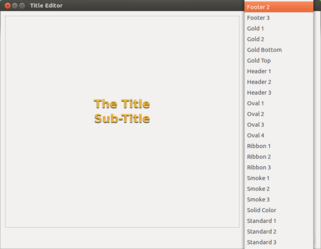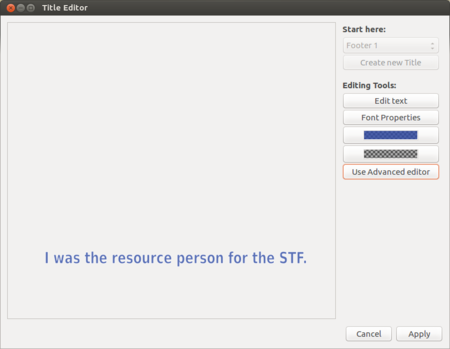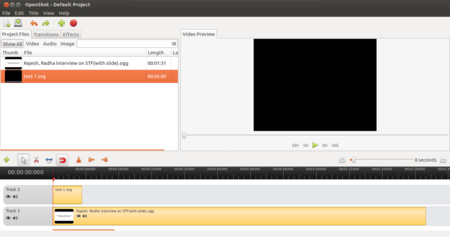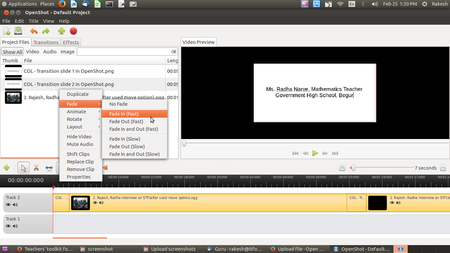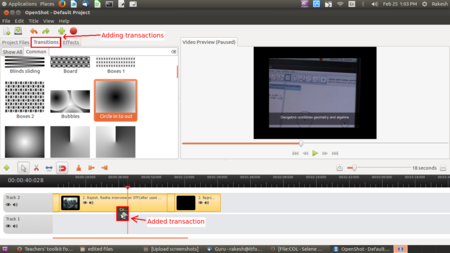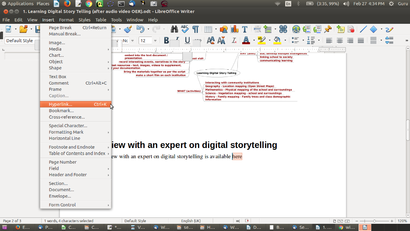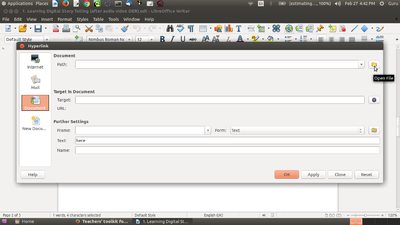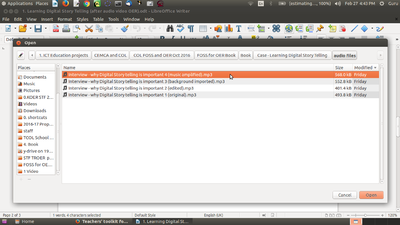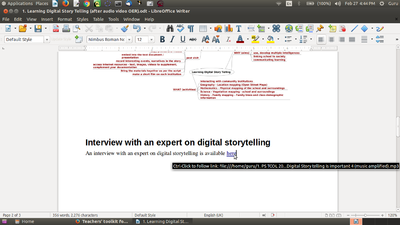Difference between revisions of "Teachers' toolkit for creating and re-purposing OER using FOSS/Audio and Video OER"
| (41 intermediate revisions by 3 users not shown) | |||
| Line 1: | Line 1: | ||
{{Navigate|Prev=Image and animation OER|Curr=Audio and Video OER|Next=File formats}} | {{Navigate|Prev=Image and animation OER|Curr=Audio and Video OER|Next=File formats}} | ||
| − | As teachers, you would no doubt appreciate the effectiveness of an audio visual communication. The audio visual format allows expression by people and this is useful for those who may have an inhibition in expressing themselves in written forms. How liberating it might be for a student struggling with the letters to be able to express a piece of creativity with an | + | As teachers, you would no doubt appreciate the effectiveness of an audio visual communication. The audio visual format allows expression by people and this is specially useful for those who may have an inhibition in expressing themselves in written forms. How liberating it might be for a student struggling with the letters to be able to express a piece of creativity with an video recording! Other than as forms of expression, an audio visual communication can be an effective form of digital story telling and creating community stories around people, events and institutions. With devices like mobiles and sound recorders, creating audio and even video files is becoming easier and more common. You will get familiar with different FOSS tools for creating, re-purposing and publishing audio and video OER can, in this chapter. |
| − | + | By the end of this chapter, you will be able to | |
| − | + | # access audio and video OER from popular repositories | |
| − | # | + | # create audio resources (using your audio recorder in your mobile phone) |
| − | # | + | # edit audio resources using an audio editor (using ''Audacity'') |
| − | # | + | # create video resources (using your video recorder in your mobile phone) |
| − | # | + | # create simple video resource using a screen-casting tool (using ''RecordMyDesktop'') |
| − | # | + | # edit video resources using a video editor (using ''OpenShot'') |
| − | # | + | # embed / insert links to audio and video resources in a text document (using ''LibreOffice Writer'') |
| − | # | + | # insert links to audio and video resources in a ‘slide presentation’ (using ''LibreOffice Impress'') |
=== Accessing audio OER repositories === | === Accessing audio OER repositories === | ||
[https://freesound.org Freesound] is an audio OER repository. You can search for sounds in this repository. [http://Soundcloud.com Soundcloud] is also an audio repository. As in the case of text and image resources, you will need to check the copyright of the audio you want to re-use. Refer to the section on OER in this toolkit if required. | [https://freesound.org Freesound] is an audio OER repository. You can search for sounds in this repository. [http://Soundcloud.com Soundcloud] is also an audio repository. As in the case of text and image resources, you will need to check the copyright of the audio you want to re-use. Refer to the section on OER in this toolkit if required. | ||
| − | You can use a search engine such as [https://google.com Google search engine] or [https://duckduckgo.com/ DuckDuckGo] search engine, using a FOSS web browser such as [https://www.mozilla.org/ Mozilla Firefox] to search the web for audio resources. | + | You can use a search engine such as [https://google.com Google search engine] or [https://duckduckgo.com/ DuckDuckGo] search engine, using a FOSS web browser such as [https://www.mozilla.org/ Mozilla Firefox] to search the web for audio resources. In the search engine, you would need to specify "videos" as a filter for search results. |
When you visit the site or check a specific resource, you need to look for copyright information to ascertain that the audio resource is OER and you can re-use it. If the resource is not explicitly declared to be an OER (allowing you to re-use), you should not use it in creating your OER. The search for audio OER is can be made easier by [[Teachers' toolkit for creating and re-purposing OER using FOSS/Text OER|providing OER as a criteria in your search itself.]] | When you visit the site or check a specific resource, you need to look for copyright information to ascertain that the audio resource is OER and you can re-use it. If the resource is not explicitly declared to be an OER (allowing you to re-use), you should not use it in creating your OER. The search for audio OER is can be made easier by [[Teachers' toolkit for creating and re-purposing OER using FOSS/Text OER|providing OER as a criteria in your search itself.]] | ||
=== Accessing video OER repositories === | === Accessing video OER repositories === | ||
| − | #[http://Youtube.com Youtube] is a popular repository for videos, it contains both OER and non OER videos. It is the largest collection of videos in the world. Note that as per [https://youtube.com/t/terms Youtube terms of use], | + | #[http://Youtube.com Youtube] is a popular repository for videos, it contains both OER and non OER videos. It is the largest collection of videos in the world. Note that as per [https://youtube.com/t/terms Youtube terms of use], if you do not see a “download” or similar link displayed by YouTube on that page, you should not download. You can use a [https://addons.mozilla.org/en-us/firefox/addon/video-downloader-player third party add-on] available in Mozilla Firefox to download videos, which are licensed under creative commons. [http://commons.wikimedia.org Wikimedia] is another resource for various media -including audio and video. |
#There are other OER video sources too, you can visit, such as Vimeo . [[wikipedia:List_of_educational_video_websites|Wikipedia]] has a list of educational video websites. A google search on ‘OER Videos’ will also give you a list of sites to explore. | #There are other OER video sources too, you can visit, such as Vimeo . [[wikipedia:List_of_educational_video_websites|Wikipedia]] has a list of educational video websites. A google search on ‘OER Videos’ will also give you a list of sites to explore. | ||
| − | + | Image 1 shows you how to filter videos on Youtube by license. | |
{| class="wikitable" | {| class="wikitable" | ||
| Line 41: | Line 41: | ||
=== Creating audio resources using your audio recorder === | === Creating audio resources using your audio recorder === | ||
| − | You can record an audio clip using your mobile phone itself, using any audio recording app, such as ‘[https://play.google.com/store/apps/details?id=com.sonymobile.androidapp.audiorecorder Audio Recorder]’. You can copy the audio file from your phone to your computer for editing and re-mixing to create OER. While recording, make sure that no copyright music or sound is playing in the background. We have recorded a short interview with a teacher on why Digital Storytelling is important, using a mobile phone(image 3). We have copied this audio clip to our computer, by connecting the mobile phone to the computer with a data cable and renamed the file as ‘Interview - why Digital Storytelling.’ | + | You can record an audio clip using your mobile phone itself, using any audio recording app, such as ‘[https://play.google.com/store/apps/details?id=com.sonymobile.androidapp.audiorecorder Audio Recorder]’. You can copy the audio file from your phone to your computer for editing and re-mixing to create OER. While recording, make sure that no copyright music or sound is playing in the background. We have recorded a short interview with a teacher on why Digital Storytelling is important, using a mobile phone (image 3). We have copied this audio clip to our computer, by connecting the mobile phone to the computer with a data cable and renamed the file as ‘Interview - why Digital Storytelling.’ |
{| class="wikitable" | {| class="wikitable" | ||
|Image 3 - [[File:Interview - why Digital Story telling is important 1 (original).ogg]]Click to listen to the audio. | |Image 3 - [[File:Interview - why Digital Story telling is important 1 (original).ogg]]Click to listen to the audio. | ||
|} | |} | ||
| − | === Editing audio resources using audio editor - Audacity === | + | === Editing audio resources using audio editor - <u rel="mw:ExtLink" href="http://www.audacityteam.org/">[[File:AudacityOGG.png|25x25px|frameless]]</u>[http://www.audacityteam.org/ Audacity] === |
[[File:COL Opening Audacity.png|left|thumb|450x450px|Image 4 - Opening Audacity]] | [[File:COL Opening Audacity.png|left|thumb|450x450px|Image 4 - Opening Audacity]] | ||
Just like text or image, audio clips can also be edited. Audacity is a audio editing software that you can use to edit your audio clips. Audacity is a simple yet powerful application for audio editing. You can also use it to record audio.<br><br> | Just like text or image, audio clips can also be edited. Audacity is a audio editing software that you can use to edit your audio clips. Audacity is a simple yet powerful application for audio editing. You can also use it to record audio.<br><br> | ||
| − | Open Audacity on your computer, through <u>Applications → Sound and Video → | + | Open Audacity on your computer, through <u>Applications → Sound and Video → [[File:AudacityOGG.png|25x25px|frameless]][http://www.audacityteam.org/ Audacity]</u> (image 4). |
To edit an audio file, we will need to ‘import’ the audio we have (of the teacher interview) into Audacity. | To edit an audio file, we will need to ‘import’ the audio we have (of the teacher interview) into Audacity. | ||
{{clear}} | {{clear}} | ||
[[File:Import_Audio.png|right|thumb|450x250px|Image 5 - Importing audio file into Audacity]] | [[File:Import_Audio.png|right|thumb|450x250px|Image 5 - Importing audio file into Audacity]] | ||
| − | To import audio, click on <u>File → | + | To import audio, click on <u>File → Import → Audio</u> and select your audio file (image 5). Audacity is very powerful audio editor, with many sophisticated features. For advanced features, refer to the [http://manual.audacityteam.org user manual] and [http://manual.audacityteam.org/man/tutorials.html tutorials]. However, we will learn a few commonly used functions, in audio editing, which are useful to teachers in creating and re-purposing OER: |
# Moving a selection of audio to rearrange audio | # Moving a selection of audio to rearrange audio | ||
# Adding a background music track to an audio | # Adding a background music track to an audio | ||
| Line 60: | Line 60: | ||
{{clear}} | {{clear}} | ||
==== Moving and combining audio clips ==== | ==== Moving and combining audio clips ==== | ||
| − | [[File:Copying_or_moving_a_selection_of_the_audio_file.png|thumb|450x450px| | + | [[File:Copying_or_moving_a_selection_of_the_audio_file.png|thumb|450x450px|Image - 6 Selecting a audio clip to move|left]] |
| − | Once you import an audio clip it will appear in Audacity | + | Once you import an audio clip it will appear in Audacity ls shown in image 6; it is called an audio track. Just like you can cut (or copy) paste a selection of text in a text document, you can cut (or copy) and paste a selection of audio in an audio file (image 6). You can use this function to remove any part of the audio clip you do not want. You can move a part of a clip from one place to another (for instance if you want to re-order responses in an interview) (image 7 and 8). |
You can also delete a part of the clip also using the same functionality. | You can also delete a part of the clip also using the same functionality. | ||
{| | {| | ||
| − | |[[File:Cut selected audio clip for moving to other place - audacity.png|thumb|450x450px| | + | |[[File:Cut selected audio clip for moving to other place - audacity.png|thumb|450x450px|Image 7 - Cut the selection part from the audio clip]] |
| − | |[[File:Paste selected audio clip to other place - audacity.png|thumb|450x450px| | + | |[[File:Paste selected audio clip to other place - audacity.png|thumb|450x450px|Image 8 - Pasting selected audio clip]] |
|} | |} | ||
| − | Listen to the following clips - the original interview on Digital Story Telling and the edited clip. Can you tell the difference? | + | Listen to the following clips - the original interview on Digital Story Telling (image 9) and the edited clip (image 10). Can you tell the difference? |
{| class="wikitable" | {| class="wikitable" | ||
| | | | ||
| Line 77: | Line 77: | ||
|[[File:Interview - why Digital Story telling is important 2 (edited).ogg]] | |[[File:Interview - why Digital Story telling is important 2 (edited).ogg]] | ||
|- | |- | ||
| − | |Original teacher interview | + | |Image 9 - Original teacher interview Audio |
| − | |Edited teacher interview | + | |Image 10 - Edited teacher interview |
|} | |} | ||
Using audacity we have selected a part of the audio track and moved this part. | Using audacity we have selected a part of the audio track and moved this part. | ||
==== Adding background music ==== | ==== Adding background music ==== | ||
| − | You may want to add background music to an audio recording. It is easy to do this with Audacity. You | + | You may want to add background music to an audio recording. It is easy to do this with Audacity. You can do this by importing another audio clip (your background music) to a second track, by clicking <u>File -> Import -> Audio </u> (image 11). We can add as many tracks as we want, with one audio file per track (image 12) by repeating the importing option. |
{| | {| | ||
| − | |[[File:Adding_a_track_in_Audacity_for_background_music.png|500x500px|Adding | + | |[[File:Adding_a_track_in_Audacity_for_background_music.png|500x500px|Image 11 - Adding second track in Audacity for background music|thumb|none]] |
| − | |[[File:Audacity_5_Multipal_Track.png|thumb|450x450px|Added multiple tracks]] | + | |[[File:Audacity_5_Multipal_Track.png|thumb|450x450px|Image 12 - Added multiple tracks]] |
|} | |} | ||
| + | |||
{| | {| | ||
|[[File:Audio file with background music added.ogg]] | |[[File:Audio file with background music added.ogg]] | ||
|- | |- | ||
| − | |Teacher interview with background music | + | |Image 13 - Teacher interview with background music |
|} | |} | ||
==== Amplifying sound ==== | ==== Amplifying sound ==== | ||
While editing an audio, you may find it necessary to adjust the sound levels in individual tracks. You can use the ‘amplify’ function to increase or reduce the sound level in a track. | While editing an audio, you may find it necessary to adjust the sound levels in individual tracks. You can use the ‘amplify’ function to increase or reduce the sound level in a track. | ||
| − | Select <u>Effect -> Amplify</u>. Reduce the amplification by moving the slider leftward. Increase the amplification by moving the slider rightward. | + | Select <u>Effect -> Amplify</u>. Reduce the amplification by moving the slider leftward (image 14). Increase the amplification by moving the slider rightward. |
| − | [[File:Amplifying_(reducing)_the_background_music.png|none|thumb|450x450px| Reducing sound amplification]] | + | [[File:Amplifying_(reducing)_the_background_music.png|none|thumb|450x450px|Image 14 - Reducing sound amplification]] |
{| class="wikitable" | {| class="wikitable" | ||
|[[File:Audio file with background music amplified (reduced).ogg]] | |[[File:Audio file with background music amplified (reduced).ogg]] | ||
|- | |- | ||
| − | | | + | |Image 15 - Audio file with amplification (sound reduced) |
|} | |} | ||
| − | You may have an audio recording where there is some unwanted disturbance throughout, such as traffic sounds. You can use the ‘Noise Reduction’ function in Audacity to reduce the background noise. | + | You may have an audio recording where there is some unwanted disturbance throughout, such as traffic sounds. You can use the ‘Noise Reduction’ function in Audacity to reduce the background noise. (Select <u>Effect -> Noise Reduction)</u> |
==== Exporting the Audacity project to create audio output file ==== | ==== Exporting the Audacity project to create audio output file ==== | ||
| − | After completing your editing tasks, select <u>File → Export</u> and select the file format as | + | After completing your editing tasks, select <u>File → Export</u> and select the file format as .ogg and click export (image 16), to create an output audio file in the .ogg format. |
| − | + | In case you would like to continue editing this file later, you should also save the Audacity project, for this select <u>File → Save.</u> | |
This will save the work done as an Audacity project. You can go back to this file (using <u>File -> Open</u>) to continue editing | This will save the work done as an Audacity project. You can go back to this file (using <u>File -> Open</u>) to continue editing | ||
| − | [[File:Audacity_7_Export_Metadata_Edit.png|none|thumb|450x450px| | + | {| |
| − | <br>Audacity is particularly useful for a language teacher to create audio resources for language learning. | + | |[[File:Audacity - file exporting as ogg.png|500x500px|Image 16a- Export edited audio as audio file|thumb|none]] |
| + | |[[File:Audacity - export audio as audio file 2.png|thumb|450x450px|Image 16b - Select ogg from format list]] | ||
| + | |} | ||
| + | [[File:Audacity_7_Export_Metadata_Edit.png|none|thumb|450x450px|Image 16c - Give the required file source details ]] | ||
| + | <br>Audacity is particularly useful for a language teacher to create audio resources for language learning. Students can hear it multiple times to become familiar with the language. The same content can be recorded in more than one language (one of which can be a language that the student is familiar with) and saved as distinct audio files. This can help the student to take the support of her competence in one language, to acquire another language. | ||
| + | |||
| + | {| class="wikitable" | ||
| + | |- | ||
| + | |'''Activity time''' - You should create audio and video resources for your topic. You could interview key resource persons on the topic, or even have a panel discussion amongst experts. You could interview practitioners and laypersons as well. Edit the audio to make it crisp, clear and coherent. | ||
| + | |||
| + | As discussed in this chapter, you should move a part of the clip to another location in the file to re-order the audio, combine two audio clips to add some background music, amplify a part of the clip and finally export the Audacity project to create audio output file. You should save the audio files in your personal digital library, you could save in a sub folder called 'Audio documents'. | ||
| + | |||
| + | You will need to practice these steps multiple times to become comfortable. In the beginning, focus on the technical aspects, on the processes in Audacity, without worrying much of the quality of the output itself. Over time, as you become comfortable in using Audacity, you will be able to focus increasingly on the audio quality rather than the steps in Audacity. | ||
| + | |||
| + | You should prepare multiple audio clips for your OER. As you keep practising, you will find the quality improve. You will also find it easier and quicker to do this. Hence patience and persistence is vital for learning to create and re-purpose audio OER. | ||
| + | |} | ||
=== Creating video resources=== | === Creating video resources=== | ||
| Line 119: | Line 135: | ||
You can record a video clip using your mobile phone itself, using the camera on the phone. While recording the video, take care to ensure that you are not shooting copyright materials or private spaces. You can copy the video file from your phone to your computer for editing and re-mixing to create OER. | You can record a video clip using your mobile phone itself, using the camera on the phone. While recording the video, take care to ensure that you are not shooting copyright materials or private spaces. You can copy the video file from your phone to your computer for editing and re-mixing to create OER. | ||
| − | ==== Creating a video resource using a screen-casting tool - [http://recordmydesktop.sourceforge.net/about.php RecordMyDesktop] ==== | + | ====Creating a video resource using a screen-casting tool - [http://recordmydesktop.sourceforge.net/about.php RecordMyDesktop] ==== |
| − | Screen casting is also a | + | Screen casting is also a simple yet powerful way of creating a video resource. The [http://recordmydesktop.sourceforge.net/about.php RecordMyDesktop] software records the computer output display as the video and audio (image 18). This can be used to record the functioning of a software or any educational application. In addition to the audio played on the computer as part of the running of the application, additional audio spoken and provided as an input to the computer can also be recorded as a part of the video. |
| + | |||
| + | You can set your computer audio output to mute, and provide the audio entirely from an external source (which can be your own voice). In this way you can combine the video from the computer with your own narrative to make a lesson plan on a topic. | ||
There are some powerful ways of using this tool for creating video OER: | There are some powerful ways of using this tool for creating video OER: | ||
| − | # You could " | + | # You could "slide show" your presentations or play your images and add a narration to it to explain further. This can be shared as supplementary materials for your class and can be used by students who need reinforcement, additional reviews of your lessons. |
| − | # You may have used a particular software or educational application to demonstrate a concept in class. You could use the | + | # You may have used a particular software or educational application to demonstrate a concept in class. You could use the screen cast application to re-create the lesson by recording your description of the activity and sharing with students. |
| − | # | + | # Dubbing a video can create a resource in another language. In a teaching setting, you may want to use an existing video, and voice over it to add explanations to reflect the language and learning context of your class; this can be done quite effectively using this application. |
| − | Make sure you are not displaying copyright material on the screen when recording the video. If you record any copyright material in the video, it will be a copyright violation. Select <u>Applications → Sound & Video → RecordMyDesktop</u> to open Record My Desktop. | + | Make sure you are not displaying copyright material on the screen when recording the video. If you record any copyright material in the video, it will be a copyright violation. Select <u>Applications → Sound & Video → RecordMyDesktop</u> (image 17) to open Record My Desktop. |
{| | {| | ||
|- | |- | ||
| − | |[[File:COL_Opening_Record_my_Desktop.png|left|thumb|450x450px|Opening Record my Desktop]] | + | |[[File:COL_Opening_Record_my_Desktop.png|left|thumb|450x450px|Image 17 - Opening Record my Desktop]] |
| − | |[[File:RecordMyDesktop_1_Main_Window.png|left|thumb|450x450px| RecordMyDesktop main window]] | + | |[[File:RecordMyDesktop_1_Main_Window.png|left|thumb|450x450px|Image 18 - RecordMyDesktop main window]] |
|} | |} | ||
'''<u>Configuring record my desktop application</u>''' | '''<u>Configuring record my desktop application</u>''' | ||
| − | There are different settings that you can choose for recording on | + | There are different settings that you can choose for recording on screen cast software based on the kind of content you are capturing on the content as well as method of sharing and publishing. Here are some pointers for changing the settings. |
{| class="wikitable" | {| class="wikitable" | ||
|- | |- | ||
| − | |[[File:COL_-_Adjusting_Video_quality_in_recordmydesktop.png|thumb|450x450px| Adjusting video quality in RecordMyDesktop|left]] | + | |[[File:COL_-_Adjusting_Video_quality_in_recordmydesktop.png|thumb|450x450px|Image 19 - Adjusting video quality in RecordMyDesktop|left]] |
| − | |[[File:COL_-_Recordmydesktop_select_area_to_record.png|right|thumb|450x450px| RecordMyDesktop select area to record]] | + | |[[File:COL_-_Recordmydesktop_select_area_to_record.png|right|thumb|450x450px|Image 20 - RecordMyDesktop select area to record]] |
|- | |- | ||
| − | |You can define the audio and video quality of your recording by moving the slider | + | |You can define the audio and video quality of your recording by moving the slider. A higher quality video means a larger file (image 19) so, you would need to decide based on the content as well as the intended use (if the video is to be published, it may be better to have a smaller output file size). A video quality of 50% is good enough for most purposes and will keep file size lower). You can also click on Advanced--->Performance to adjust the frame per second to adjust video quality. <br> |
| − | |You can also select the window of the screen which you want to record. Click on <u>Select window</u>, you will be asked to grab the area to select. You can select only that part of the screen that you want to record. This is useful if you are opening photos or playing a video on only part of your screen and want to record that part only. | + | |You can also select the window of the screen which you want to record. Click on <u>Select window</u> (image 20), you will be asked to grab the area to select. You can select only that part of the screen that you want to record. This is useful if you are opening photos or playing a video on only part of your screen and want to record that part only. |
|} | |} | ||
| Line 149: | Line 167: | ||
{| class="wikitable" | {| class="wikitable" | ||
|- | |- | ||
| − | |[[File:RecordMyDesktop_6_Red_Button.png|left|thumb|450x450px| Recording video using RecordMyDesktop]] | + | |[[File:RecordMyDesktop_6_Red_Button.png|left|thumb|450x450px|Image 21 - Recording video using RecordMyDesktop]] |
| − | |[[File:Exporting recording as video.png|thumb|650x550px|Exporting output file on RecordMyDesktop]] | + | |[[File:Exporting recording as video.png|thumb|650x550px|Image 22 - Exporting output file on RecordMyDesktop]] |
|- | |- | ||
| − | |When you click on <u>Record</u> button, desktop recording will start. The recording can be paused and resumed at any time, by right clicking on the RecordMyDesktop icon in the top panel and selecting <u>Pause</u> (and later <u>Resume</u> when you want to continue recording). Clicking on ‘Stop’ will stop the recording and initiate the export of the video output. | + | |When you click on <u>Record</u> button, desktop recording will start (image 21). The recording can be paused and resumed at any time, by right clicking on the RecordMyDesktop icon in the top panel and selecting <u>Pause</u> (and later <u>Resume</u> when you want to continue recording). Clicking on ‘Stop’ will stop the recording and initiate the export of the video output. |
| − | |We need to wait till the export is completed, to get the output file. If we close the process before, we will lose the output file. The output file will be saved in your "Home" folder by default, with . | + | |We need to wait till the export is completed, to get the output file (image 22). If we close the process before, we will lose the output file. The output file will be saved in your "Home" folder by default, with .ogv format. The file will usually have a name like ‘out.ogv’, however you can use the ‘save as’ button on the RecordMyDesktop screen to give a file name of your choice. |
|} | |} | ||
| Line 169: | Line 187: | ||
|- | |- | ||
|{{Youtube|F1wX85-ub3o}} | |{{Youtube|F1wX85-ub3o}} | ||
| − | <br> Video - Original in Kannada <br> | + | <br>Image-22a Video - Original in Kannada <br> |
|{{Youtube|0tKJX6EU0tM}} | |{{Youtube|0tKJX6EU0tM}} | ||
| − | <br>Video - Dubbed to English <br> | + | <br>Image-22b Video - Dubbed to English <br> |
| + | |} | ||
| + | {| class="wikitable" | ||
| + | |- | ||
| + | |'''Activity time''' - Take any OER video you like, which is in accented English spoken in the USA or UK and dub it with your own voice, in English or your native language. Save the video files in your personal digital library, you could save in a sub folder called 'Video documents'. The effectiveness of this editing will depend on how well you have prepared the script to match the original video. Also to make the recording more effective, you should use a microphone connected to the computer. You should record a couple of times and listen to it, to get feedback on what to do to improve, such as raising the audio volume, providing gaps and voice modulations etc. After you practice a few times, you are bound to get a good video! | ||
|} | |} | ||
| − | |||
| − | |||
| − | |||
| − | Open OpenShot on your computer, through <u>Applications → Sound and Video → OpenShot. Import your video into OpenShot through <u>File → Open</u> | + | ==== Using video editor to reuse videos - [[File:OpenShot logo.svg|frameless|20x20px]][http://www.openshot.org/ Openshot] ==== |
| + | You may also want to edit your videos in other ways - including adding narration to specific parts, adding text (including subtitles), photographs or adding music or additional sounds. Open Shot Video editor is is a simple yet powerful application that allows you to do these things. Just like in Audacity, when you use Open Shot editor, your video or audio clips will be shown as tracks and by moving and combining, you can edit the files as needed. | ||
| + | |||
| + | Open OpenShot on your computer, through <u>Applications → Sound and Video →</u>[[File:OpenShot logo.svg|frameless|20x20px]] <u>OpenShot</u> (image 23). Import your video into OpenShot through <u>File → Open</u> and select your video file (image 24). You can also add images or audio clips that you want to add to the video by importing these as tracks. | ||
{| | {| | ||
| − | |[[File:Opening Openshot video editor.png|none|thumb|450x450px| | + | |[[File:Opening Openshot video editor.png|none|thumb|450x450px|Image 23 - Opening OpenShot video editor from menu]] |
| − | |[[File:COL_open_shot_importing_files.png|left|thumb|500x500px| | + | |[[File:COL_open_shot_importing_files.png|left|thumb|500x500px|Image 24 - Import video into OpenShot]] |
|} | |} | ||
<br>This software is very powerful with many sophisticated features (for advanced features, refer to the [http://www.openshotusers.com/help/1.3/en/ user manual and tutorials)] . However, we will learn a few commonly used functions, in video editing, which are useful to teachers in creating and re-purposing OER: | <br>This software is very powerful with many sophisticated features (for advanced features, refer to the [http://www.openshotusers.com/help/1.3/en/ user manual and tutorials)] . However, we will learn a few commonly used functions, in video editing, which are useful to teachers in creating and re-purposing OER: | ||
| Line 191: | Line 213: | ||
==== Moving a selection of video ==== | ==== Moving a selection of video ==== | ||
| − | We saw earlier that audio clip can be cut and pasted like text documents. A similar moving and combining is possible for video clips also. You can do this in Open Shot video editor application, by cutting and using drag and drop options of the video file. You can also delete a part of the clip also using delete key from the keyboard (or right click and remove clip) and remove any part of the video clip you do not want. You can move a part of a clip from one place to another (for instance if you want to re-order responses in an interview). | + | We saw earlier that audio clip can be cut and pasted like text documents. A similar moving and combining is possible for video clips also. You can do this in Open Shot video editor application, by cutting (image 25) and using drag and drop options of the video file. You can also delete a part of the clip also using delete key from the keyboard (or right click and remove clip) and remove any part of the video clip you do not want. You can move a part of a clip (image 26) from one place to another (for instance if you want to re-order responses in an interview). |
{| | {| | ||
| − | |[[File:Cutting video clip by using cut tool - openshot.png|left|thumb|500x500px|Cutting video clip by using cut tool]] | + | |[[File:Cutting video clip by using cut tool - openshot.png|left|thumb|500x500px|Image 25 - Cutting video clip by using cut tool]] |
| − | |[[File:2._moving_video_clips_part_by_dragging_.png|none|thumb|500x500px|Moving a video clip by dragging and draping ]] | + | |[[File:2._moving_video_clips_part_by_dragging_.png|none|thumb|500x500px|Image 26 - Moving a video clip by dragging and draping ]] |
|} | |} | ||
| − | To demonstrate this we have edited a video where two teachers (one male and second female) are speaking about their work in integrating technology in their subject teaching. (Author of video - IT for Change). We have used this option to move the interview of the male teacher after the interview of the female teacher. Watch the two videos below. | + | To demonstrate this we have edited a video where two teachers (one male and second female) are speaking about their work in integrating technology in their subject teaching (image 27). (Author of video - IT for Change). We have used this option to move the interview of the male teacher after the interview of the female teacher (image28). Watch the two videos below. |
{| class="wikitable" | {| class="wikitable" | ||
|{{Youtube|LqM1sSgocZk|320|220}} | |{{Youtube|LqM1sSgocZk|320|220}} | ||
|{{Youtube|lHyETFkJN-o}} | |{{Youtube|lHyETFkJN-o}} | ||
|- | |- | ||
| − | |Original video | + | |Image 27 - Original video |
| − | |Edited video where<br> | + | |Image 28 - Edited video where<br> |
interviews are interchanged | interviews are interchanged | ||
|} | |} | ||
==== Adding a slide ==== | ==== Adding a slide ==== | ||
| − | Often you want to add images or text to a video. These can be inserted as slides. By inserting the slides at different times in the track, we can add images or text to a video. To demonstrate this, we have worked with our video of teachers and introduced a title slide introducing each teacher before they begin speaking. You can add slides as required to introduce your own narrative in your video to practice. | + | Often you want to add images or text to a video. These can be inserted as slides. By inserting the slides at different times in the track, we can add images or text to a video. To demonstrate this, we have worked with our video of teachers and introduced a title slide introducing each teacher before they begin speaking (image 29). You can add slides as required to introduce your own narrative in your video to practice. |
{| class="wikitable" | {| class="wikitable" | ||
| − | |[[File:3._Inserting_slides_into_video_.png|none|thumb|450x450px| Adding image slide into video track]] | + | |[[File:3._Inserting_slides_into_video_.png|none|thumb|450x450px|Image 29 - Adding image slide into video track]] |
| | | | ||
| − | Video - See video where two <br> | + | {{Youtube|UPbOmQ_eX-k}} |
| + | Image 30 - Video - See video where two <br> | ||
introducing slides have been added <br> | introducing slides have been added <br> | ||
| − | |||
|} | |} | ||
| − | + | ==== Sub-titling existing videos ==== | |
| − | + | You can provide sub-titles to the video, this will provide text input to supplement the audio/video. You can provide the sub-titles in English or in your native language. First we have to create our subtitle file by selecting <u>Title -> create new title</u>. | |
| − | [[File:COL_-_Adding_subtittle_to_the_track_.png|none|thumb|321x321px| Opening title creation window]] | + | [[File:COL_-_Adding_subtittle_to_the_track_.png|none|thumb|321x321px|Image 31 Opening title creation window]] |
| − | Here, | + | Here, select the style of your sub-title (we have selected <u>Footer3</u> (image 31)- this will give 'my sub-title' in the footer area) and click on '''<nowiki/>'create new Title'''<nowiki/>'. |
| − | [[File:COL_adding_Sub-title_-_openshot.png|none|thumb|450x450px|Adding a sub-title in a video]] | + | [[File:COL_adding_Sub-title_-_openshot.png|none|thumb|450x450px|Image 32 - Adding a sub-title in a video]] |
| − | You should give a name for your sub-title file, then enter the text you want as the subtitle, and click <u>Apply</u>. This sub title text will be added to your project file. | + | You should give a name for your sub-title file, then enter the text you want as the subtitle (image 32), and click <u>Apply</u>. This sub title text will be added to your project file. |
[[File:COL_added_sub_title_file_into_the_track.png|none|thumb|450x450px|Adding the subtitle text file into the new track (second track).]] | [[File:COL_added_sub_title_file_into_the_track.png|none|thumb|450x450px|Adding the subtitle text file into the new track (second track).]] | ||
| − | ''Video - See the video where we have added subtitle'' | + | Image 33 - ''Video - See the video where we have added subtitle'' |
{{Youtube|1=A7pt9NPEEcc}} | {{Youtube|1=A7pt9NPEEcc}} | ||
====Adding fade in and fade out ==== | ====Adding fade in and fade out ==== | ||
| − | By adding fade-in and fade-out for the clips, it will smoothly | + | By adding fade-in and fade-out for the clips, it will smoothly change the slides from one to next. You should right click your mouse, on the slide and select <u>Fade -> Fade in</u> or <u>Fade Out</u> as per the requirement (image 34). This fade in / fade out will effect for both audio and video. <br> |
| − | [[File:4._add_fade_in_and_fade_out.png|none|thumb|450x450px|Adding fade in, fade out for slides and for video clips.]] | + | [[File:4._add_fade_in_and_fade_out.png|none|thumb|450x450px|Image 34 - Adding fade in, fade out for slides and for video clips.]] |
| − | <br>{{Youtube|VFQNcbLe-a8}} | + | <br> |
| + | Image 35 - Added fade in and fade out in the video. <br> | ||
| + | {{Youtube|VFQNcbLe-a8}} | ||
==== Adding a transition ==== | ==== Adding a transition ==== | ||
| − | You may want to add a 'transition' in your video, to introduce a new section. For instance you are moving between showing an interview of a person | + | You may want to add a 'transition' in your video, to introduce a new section. For instance you are moving between showing an interview of a person and visuals of a program, and want to have a separation between the two. Introducing a transition every time you switch will make the video easier to follow. You can do this selecting <u>Transition</u>, you will see icons of different transitions. Select one transition and drag-drop it on the video, at the spot you want to introduce the transition.<br> |
| − | [[File:4._adding_transaction.png|none|thumb|450x450px| Adding transition (different effects) into the track.]] | + | [[File:4._adding_transaction.png|none|thumb|450x450px|Image 36 - Adding transition (different effects) into the track.]] |
| − | '' | + | Image 37 -'' In this video we have added transition in 0.35 sec time frame. '' <br> |
| + | {{Youtube|b0XQCJh-dhc}} | ||
| + | <br> | ||
| + | |||
| + | {| class="wikitable" | ||
| + | |- | ||
| + | |'''Activity time''' - You can record videos using your phone, or through RecordMyDesktop. The interviews mentioned above can be video recordings as well. You can bring together a series of images and add your own audio narrative to make a video, using either RecordMyDesktop or OpenShot editor. Edit the videos to make it crisp, clear and coherent. Add background music, transition slides as required, following the steps discussed in the chapter. Save the video files in your personal digital library, you could save in a sub folder called 'Video documents'. | ||
| + | You will need to practice these steps multiple times to become comfortable. In the beginning, focus on the technical aspects, on the processes in RecordMyDesktop and OpenShot, without worrying much of the quality of the output itself. Over time, as you become comfortable in using Audacity, you will be able to focus increasingly on the audio and video quality rather than the steps in the software. | ||
| − | + | You should prepare multiple video clips for your OER. As you keep practising, you will find the quality improve. You will also find it easier and quicker to do this. Hence patience and persistence is vital for learning to create and re-purpose audio OER. Creating and re-purposing video resource is perhaps the most difficult and complex and hence you should feel a sense of satisfaction when you are able to complete a video OER for your use, or that of your students. A video OER can be very useful for any subject teacher, and for any topic you want to teach or learn about. | |
| − | |||
| − | + | Do try to create videos by dubbing an existing video, in your own voice, in your own language. Creating educational videos in languages other than English will be quite useful to students learning in these languages. | |
| + | |} | ||
=== Different resource formats can be accessed together === | === Different resource formats can be accessed together === | ||
| − | ==== Inserting links to audio and video resources in a text document | + | ==== Inserting links to audio and video resources in a text document - [http://libreoffice.org/ LibreOffice Writer] ==== |
| − | We saw earlier that you can add images to a text document. In the video, we have added text and image as well. It is also possible to provide links and references to an audio / video file in a text document to provide a multimedia experience to the reader. There is an important difference between images and audio/video when integrating with a text document. While an image is embedded within the text document, an audio or video file resides out of the text document in a file folder and is separately accessed to play. This is done by inserting a hyper-link to the audio file or video file in your computer, to the document. Clicking on this link will access the audio/ video and play it. While publishing on a web page | + | We saw earlier that you can add images to a text document. In the video, we have added text and image as well. It is also possible to provide links and references to an audio / video file in a text document to provide a multimedia experience to the reader. There is an important difference between images and audio/video when integrating with a text document. While an image is embedded within the text document, an audio or video file resides out of the text document in a file folder and is separately accessed to play. This is done by inserting a hyper-link to the audio file or video file in your computer, to the document. Clicking on this link will access the audio/ video and play it, using the audio/video player. While publishing on a web page, it is possible for different formats to be displayed on a single page. We saw earlier that file links and hyper links can be added to a text document; we use the same approach to link an audio/ video. |
| − | To try this, we will open our 'Learning Digital Story Telling.odt' and insert a hyper-link to the audio interview with an expert on Digital Storytelling. We begin by creating a section called 'Interview with an expert on digital storytelling' and enter the text | + | To try this, we will open our '[[:File:Learning Digital Story Telling (after audio video OER).odt|Learning Digital Story Telling.odt]]' and insert a hyper-link to the audio interview with an expert on Digital Storytelling. We begin by creating a section called 'Interview with an expert on digital storytelling' and enter the text |
| − | "An interview with an expert on digital storytelling is available here". We will select the text 'here' and then ( | + | "An interview with an expert on digital storytelling is available here". We will select the text 'here' and then (image 38) select <u>Insert -> Hyperlink</u>. In the window that opens, we need to click on the 'Document' icon on the left frame (image 39), and then click on the folder icon on the form (image 40), to select the path (location) of the audio file and the file. We will see the hyper link in the text file (image 41). |
{| | {| | ||
|- | |- | ||
| − | |[[File:COL - Inserting a hyperlink to an audio file in a text document -1.png|410x250px| | + | |[[File:COL - Inserting a hyperlink to an audio file in a text document -1.png|410x250px|Image 38 - Inserting a hyper-link in a text document |thumb|left]] |
| − | |[[File:COL - Inserting hyperlink to audio file on your computer - 3.png|none|thumb|400x250px| | + | |[[File:COL - Inserting hyperlink to audio file on your computer - 3.png|none|thumb|400x250px|Image 39 - Inserting hyper link to audio file on your computer - selecting 'Document' icon and 'path']] |
|} | |} | ||
{| | {| | ||
|- | |- | ||
| − | |[[File:COL - Inserting hyper link to audio file on your computer - 4.png|400x250px| | + | |[[File:COL - Inserting hyper link to audio file on your computer - 4.png|400x250px|Image 40 - Inserting hyper link to audio file on your computer - selecting the audio file|thumb|left]] |
| − | |[[File:COL - Inserting hyper link to audio file on your computer - 5.png|none|thumb|400x250px| | + | |[[File:COL - Inserting hyper link to audio file on your computer - 5.png|none|thumb|400x250px|Image 41 - Inserting hyper link to audio file on your computer - hyper link in the document]] |
|} | |} | ||
If you 'control-click' on this link (that is press control and simultaneously press the mouse left click), the link will play the audio file on your computer. You can follow an identical process to insert a link to a video file on your computer. | If you 'control-click' on this link (that is press control and simultaneously press the mouse left click), the link will play the audio file on your computer. You can follow an identical process to insert a link to a video file on your computer. | ||
| − | ==== Inserting links in a ‘slide presentation’ format | + | ==== Inserting links in a ‘slide presentation’ format [http://libreoffice.org/ LibreOffice Impress] ==== |
| − | [[File:COL - Inserting a hyperlink to a video file in a slide presentation.png|right|thumb|450x450px|Inserting a hyperlink to a video file in a slide presentation]] | + | [[File:COL - Inserting a hyperlink to a video file in a slide presentation.png|right|thumb|450x450px|Image 42 - Inserting a hyperlink to a video file in a slide presentation]] |
| − | Inserting links in your slide presentation document, to file on your computer, is identical to the process followed in LibreOffice Writer. We have inserted a hyper-link to a video file on our computer "Interview with two teachers of the Subject Teacher Forum program - with transition.ogg" in the slide, to the word 'Video' in the slide presentation. In the 'normal slide view', you will need to 'control-click' to open the video. In the 'Slide Show' view, simply clicking on the link will play the video. | + | Inserting links in your slide presentation document, to file on your computer, is identical to the process followed in LibreOffice Writer. We have inserted a hyper-link to a video file on our computer "Interview with two teachers of the Subject Teacher Forum program - with transition.ogg" in the slide, to the word 'Video' in the slide presentation. In the 'normal slide view', you will need to 'control-click' to open the video. In the 'Slide Show' view, simply clicking on the link will play the video (image 42). |
{{clear}} | {{clear}} | ||
| − | Work on your text document and slide presentation. The text document can be a detailed and rich explanation for the topic you have chosen, while the slide presentation can be a crisp outline of the main points you want to communicate about. Insert, as relevant, images as well as hyper links to web pages, audio and video files on your computer, to make an interesting narrative on the topic. Read the documents multiple times, to review and refine. Request your colleagues to also read and review it and offer feedback. The 'review-revise' loop is an important and iterative one that makes for a good quality OER!! | + | |
| + | {| class="wikitable" | ||
| + | |- | ||
| + | |'''Activity time''' - Work on your text document and slide presentation. The text document can be a detailed and rich explanation for the topic you have chosen, while the slide presentation can be a crisp outline of the main points you want to communicate about. Insert, as relevant, images as well as hyper links to web pages, audio and video files on your computer, to make an interesting narrative on the topic. Read the documents multiple times, to review and refine. Request your colleagues to also read and review it and offer feedback. The 'review-revise' loop is an important and iterative one that makes for a good quality OER!! | ||
| + | |} | ||
=== Alternative applications and alternative platforms === | === Alternative applications and alternative platforms === | ||
| + | Audacity and OpenShot are available on Windows as well. The functions and menu options of these applications on Windows is similar to those on Ubuntu platform. Learning Audacity and OpenShot on Windows is similar to learning it on Ubuntu | ||
| + | |||
Please refer to [[Teachers'_toolkit_for_creating_and_re-purposing_OER_using_FOSS/Annexure|Annexure]], for a list of equivalent Free and Open Source Software applications on the GNU/Linux, Microsoft Windows and Android (Mobile phone) platforms and on the web. | Please refer to [[Teachers'_toolkit_for_creating_and_re-purposing_OER_using_FOSS/Annexure|Annexure]], for a list of equivalent Free and Open Source Software applications on the GNU/Linux, Microsoft Windows and Android (Mobile phone) platforms and on the web. | ||
| + | ___________________________________________________________________________________________________________________ | ||
| + | |||
| + | '''The Teachers' toolkit for creating and re-purposing OER using FOSS tools is licensed under [https://creativecommons.org/licenses/by/4.0/ CC BY 4.0] license''' | ||
[[Category:Teachers' toolkit for creating and re-purposing OER using FOSS]] | [[Category:Teachers' toolkit for creating and re-purposing OER using FOSS]] | ||
Latest revision as of 12:50, 14 June 2017
As teachers, you would no doubt appreciate the effectiveness of an audio visual communication. The audio visual format allows expression by people and this is specially useful for those who may have an inhibition in expressing themselves in written forms. How liberating it might be for a student struggling with the letters to be able to express a piece of creativity with an video recording! Other than as forms of expression, an audio visual communication can be an effective form of digital story telling and creating community stories around people, events and institutions. With devices like mobiles and sound recorders, creating audio and even video files is becoming easier and more common. You will get familiar with different FOSS tools for creating, re-purposing and publishing audio and video OER can, in this chapter.
By the end of this chapter, you will be able to
- access audio and video OER from popular repositories
- create audio resources (using your audio recorder in your mobile phone)
- edit audio resources using an audio editor (using Audacity)
- create video resources (using your video recorder in your mobile phone)
- create simple video resource using a screen-casting tool (using RecordMyDesktop)
- edit video resources using a video editor (using OpenShot)
- embed / insert links to audio and video resources in a text document (using LibreOffice Writer)
- insert links to audio and video resources in a ‘slide presentation’ (using LibreOffice Impress)
Accessing audio OER repositories
Freesound is an audio OER repository. You can search for sounds in this repository. Soundcloud is also an audio repository. As in the case of text and image resources, you will need to check the copyright of the audio you want to re-use. Refer to the section on OER in this toolkit if required.
You can use a search engine such as Google search engine or DuckDuckGo search engine, using a FOSS web browser such as Mozilla Firefox to search the web for audio resources. In the search engine, you would need to specify "videos" as a filter for search results.
When you visit the site or check a specific resource, you need to look for copyright information to ascertain that the audio resource is OER and you can re-use it. If the resource is not explicitly declared to be an OER (allowing you to re-use), you should not use it in creating your OER. The search for audio OER is can be made easier by providing OER as a criteria in your search itself.
Accessing video OER repositories
- Youtube is a popular repository for videos, it contains both OER and non OER videos. It is the largest collection of videos in the world. Note that as per Youtube terms of use, if you do not see a “download” or similar link displayed by YouTube on that page, you should not download. You can use a third party add-on available in Mozilla Firefox to download videos, which are licensed under creative commons. Wikimedia is another resource for various media -including audio and video.
- There are other OER video sources too, you can visit, such as Vimeo . Wikipedia has a list of educational video websites. A google search on ‘OER Videos’ will also give you a list of sites to explore.
Image 1 shows you how to filter videos on Youtube by license.
You can enter your topic name in the search bar in Youtube to search for videos on that topic. To get videos which you can re-use, you need to click on the ‘Filter’ link on the Youtube page and select ‘Creative Commons’ (image 1), with this step you will see videos that have the CC license (are OER).
You can click on the video, this will open the video and it will begin playing. You can download the video by clicking on the download link below the video (image 2). You can download in different formats.
Creating audio resources using your audio recorder
You can record an audio clip using your mobile phone itself, using any audio recording app, such as ‘Audio Recorder’. You can copy the audio file from your phone to your computer for editing and re-mixing to create OER. While recording, make sure that no copyright music or sound is playing in the background. We have recorded a short interview with a teacher on why Digital Storytelling is important, using a mobile phone (image 3). We have copied this audio clip to our computer, by connecting the mobile phone to the computer with a data cable and renamed the file as ‘Interview - why Digital Storytelling.’
| Image 3 - Click to listen to the audio. |
Editing audio resources using audio editor -  Audacity
Audacity
Just like text or image, audio clips can also be edited. Audacity is a audio editing software that you can use to edit your audio clips. Audacity is a simple yet powerful application for audio editing. You can also use it to record audio.
Open Audacity on your computer, through Applications → Sound and Video → ![]() Audacity (image 4).
To edit an audio file, we will need to ‘import’ the audio we have (of the teacher interview) into Audacity.
Audacity (image 4).
To edit an audio file, we will need to ‘import’ the audio we have (of the teacher interview) into Audacity.
To import audio, click on File → Import → Audio and select your audio file (image 5). Audacity is very powerful audio editor, with many sophisticated features. For advanced features, refer to the user manual and tutorials. However, we will learn a few commonly used functions, in audio editing, which are useful to teachers in creating and re-purposing OER:
- Moving a selection of audio to rearrange audio
- Adding a background music track to an audio
- Reducing background noise levels
Moving and combining audio clips
Once you import an audio clip it will appear in Audacity ls shown in image 6; it is called an audio track. Just like you can cut (or copy) paste a selection of text in a text document, you can cut (or copy) and paste a selection of audio in an audio file (image 6). You can use this function to remove any part of the audio clip you do not want. You can move a part of a clip from one place to another (for instance if you want to re-order responses in an interview) (image 7 and 8).
You can also delete a part of the clip also using the same functionality.
Listen to the following clips - the original interview on Digital Story Telling (image 9) and the edited clip (image 10). Can you tell the difference?
|
|
||
| Image 9 - Original teacher interview Audio | Image 10 - Edited teacher interview |
Using audacity we have selected a part of the audio track and moved this part.
Adding background music
You may want to add background music to an audio recording. It is easy to do this with Audacity. You can do this by importing another audio clip (your background music) to a second track, by clicking File -> Import -> Audio (image 11). We can add as many tracks as we want, with one audio file per track (image 12) by repeating the importing option.
| Image 13 - Teacher interview with background music |
Amplifying sound
While editing an audio, you may find it necessary to adjust the sound levels in individual tracks. You can use the ‘amplify’ function to increase or reduce the sound level in a track. Select Effect -> Amplify. Reduce the amplification by moving the slider leftward (image 14). Increase the amplification by moving the slider rightward.
| Image 15 - Audio file with amplification (sound reduced) |
You may have an audio recording where there is some unwanted disturbance throughout, such as traffic sounds. You can use the ‘Noise Reduction’ function in Audacity to reduce the background noise. (Select Effect -> Noise Reduction)
Exporting the Audacity project to create audio output file
After completing your editing tasks, select File → Export and select the file format as .ogg and click export (image 16), to create an output audio file in the .ogg format.
In case you would like to continue editing this file later, you should also save the Audacity project, for this select File → Save.
This will save the work done as an Audacity project. You can go back to this file (using File -> Open) to continue editing
Audacity is particularly useful for a language teacher to create audio resources for language learning. Students can hear it multiple times to become familiar with the language. The same content can be recorded in more than one language (one of which can be a language that the student is familiar with) and saved as distinct audio files. This can help the student to take the support of her competence in one language, to acquire another language.
| Activity time - You should create audio and video resources for your topic. You could interview key resource persons on the topic, or even have a panel discussion amongst experts. You could interview practitioners and laypersons as well. Edit the audio to make it crisp, clear and coherent.
As discussed in this chapter, you should move a part of the clip to another location in the file to re-order the audio, combine two audio clips to add some background music, amplify a part of the clip and finally export the Audacity project to create audio output file. You should save the audio files in your personal digital library, you could save in a sub folder called 'Audio documents'. You will need to practice these steps multiple times to become comfortable. In the beginning, focus on the technical aspects, on the processes in Audacity, without worrying much of the quality of the output itself. Over time, as you become comfortable in using Audacity, you will be able to focus increasingly on the audio quality rather than the steps in Audacity. You should prepare multiple audio clips for your OER. As you keep practising, you will find the quality improve. You will also find it easier and quicker to do this. Hence patience and persistence is vital for learning to create and re-purpose audio OER. |
Creating video resources
Creating video resources using your video recorder
You can record a video clip using your mobile phone itself, using the camera on the phone. While recording the video, take care to ensure that you are not shooting copyright materials or private spaces. You can copy the video file from your phone to your computer for editing and re-mixing to create OER.
Creating a video resource using a screen-casting tool - RecordMyDesktop
Screen casting is also a simple yet powerful way of creating a video resource. The RecordMyDesktop software records the computer output display as the video and audio (image 18). This can be used to record the functioning of a software or any educational application. In addition to the audio played on the computer as part of the running of the application, additional audio spoken and provided as an input to the computer can also be recorded as a part of the video.
You can set your computer audio output to mute, and provide the audio entirely from an external source (which can be your own voice). In this way you can combine the video from the computer with your own narrative to make a lesson plan on a topic.
There are some powerful ways of using this tool for creating video OER:
- You could "slide show" your presentations or play your images and add a narration to it to explain further. This can be shared as supplementary materials for your class and can be used by students who need reinforcement, additional reviews of your lessons.
- You may have used a particular software or educational application to demonstrate a concept in class. You could use the screen cast application to re-create the lesson by recording your description of the activity and sharing with students.
- Dubbing a video can create a resource in another language. In a teaching setting, you may want to use an existing video, and voice over it to add explanations to reflect the language and learning context of your class; this can be done quite effectively using this application.
Make sure you are not displaying copyright material on the screen when recording the video. If you record any copyright material in the video, it will be a copyright violation. Select Applications → Sound & Video → RecordMyDesktop (image 17) to open Record My Desktop.
Configuring record my desktop application
There are different settings that you can choose for recording on screen cast software based on the kind of content you are capturing on the content as well as method of sharing and publishing. Here are some pointers for changing the settings.
| You can define the audio and video quality of your recording by moving the slider. A higher quality video means a larger file (image 19) so, you would need to decide based on the content as well as the intended use (if the video is to be published, it may be better to have a smaller output file size). A video quality of 50% is good enough for most purposes and will keep file size lower). You can also click on Advanced--->Performance to adjust the frame per second to adjust video quality. |
You can also select the window of the screen which you want to record. Click on Select window (image 20), you will be asked to grab the area to select. You can select only that part of the screen that you want to record. This is useful if you are opening photos or playing a video on only part of your screen and want to record that part only. |
Recording and exporting
| When you click on Record button, desktop recording will start (image 21). The recording can be paused and resumed at any time, by right clicking on the RecordMyDesktop icon in the top panel and selecting Pause (and later Resume when you want to continue recording). Clicking on ‘Stop’ will stop the recording and initiate the export of the video output. | We need to wait till the export is completed, to get the output file (image 22). If we close the process before, we will lose the output file. The output file will be saved in your "Home" folder by default, with .ogv format. The file will usually have a name like ‘out.ogv’, however you can use the ‘save as’ button on the RecordMyDesktop screen to give a file name of your choice. |
Editing video resources
Dubbing a video using Record My Desktop
One of the most common ways of editing a video is to dub it in another language. For instance, you may find many OER videos where the language or accent is not easy to understand and you may want to change the language of narration to your own native language, to make the video more useful to your students.
To dub a video using record my desktop , you need to set the sound settings on your computer to ‘mute’ (no output). Then start record my desktop application and play the video. As the video plays, read out your script. The audio read out by you will be combined with the video being shown on the screen to create the video in your language.
We have taken a video of a teacher speaking in Kannada about a program he has been a part of, and dubbed it in English.
|
|
|
| Activity time - Take any OER video you like, which is in accented English spoken in the USA or UK and dub it with your own voice, in English or your native language. Save the video files in your personal digital library, you could save in a sub folder called 'Video documents'. The effectiveness of this editing will depend on how well you have prepared the script to match the original video. Also to make the recording more effective, you should use a microphone connected to the computer. You should record a couple of times and listen to it, to get feedback on what to do to improve, such as raising the audio volume, providing gaps and voice modulations etc. After you practice a few times, you are bound to get a good video! |
Using video editor to reuse videos -  Openshot
Openshot
You may also want to edit your videos in other ways - including adding narration to specific parts, adding text (including subtitles), photographs or adding music or additional sounds. Open Shot Video editor is is a simple yet powerful application that allows you to do these things. Just like in Audacity, when you use Open Shot editor, your video or audio clips will be shown as tracks and by moving and combining, you can edit the files as needed.
Open OpenShot on your computer, through Applications → Sound and Video →![]() OpenShot (image 23). Import your video into OpenShot through File → Open and select your video file (image 24). You can also add images or audio clips that you want to add to the video by importing these as tracks.
OpenShot (image 23). Import your video into OpenShot through File → Open and select your video file (image 24). You can also add images or audio clips that you want to add to the video by importing these as tracks.
This software is very powerful with many sophisticated features (for advanced features, refer to the user manual and tutorials) . However, we will learn a few commonly used functions, in video editing, which are useful to teachers in creating and re-purposing OER:
- Moving a selection of video and combining
- Adding a slide (this can be used for sub-titling as well)
- Adding fade in and fade out
- Adding a transition
Moving a selection of video
We saw earlier that audio clip can be cut and pasted like text documents. A similar moving and combining is possible for video clips also. You can do this in Open Shot video editor application, by cutting (image 25) and using drag and drop options of the video file. You can also delete a part of the clip also using delete key from the keyboard (or right click and remove clip) and remove any part of the video clip you do not want. You can move a part of a clip (image 26) from one place to another (for instance if you want to re-order responses in an interview).
To demonstrate this we have edited a video where two teachers (one male and second female) are speaking about their work in integrating technology in their subject teaching (image 27). (Author of video - IT for Change). We have used this option to move the interview of the male teacher after the interview of the female teacher (image28). Watch the two videos below.
|
|
|
| Image 27 - Original video | Image 28 - Edited video where interviews are interchanged |
Adding a slide
Often you want to add images or text to a video. These can be inserted as slides. By inserting the slides at different times in the track, we can add images or text to a video. To demonstrate this, we have worked with our video of teachers and introduced a title slide introducing each teacher before they begin speaking (image 29). You can add slides as required to introduce your own narrative in your video to practice.
|
|
Sub-titling existing videos
You can provide sub-titles to the video, this will provide text input to supplement the audio/video. You can provide the sub-titles in English or in your native language. First we have to create our subtitle file by selecting Title -> create new title.
Here, select the style of your sub-title (we have selected Footer3 (image 31)- this will give 'my sub-title' in the footer area) and click on 'create new Title'.
You should give a name for your sub-title file, then enter the text you want as the subtitle (image 32), and click Apply. This sub title text will be added to your project file.
Image 33 - Video - See the video where we have added subtitle
Adding fade in and fade out
By adding fade-in and fade-out for the clips, it will smoothly change the slides from one to next. You should right click your mouse, on the slide and select Fade -> Fade in or Fade Out as per the requirement (image 34). This fade in / fade out will effect for both audio and video.
Image 35 - Added fade in and fade out in the video.
Adding a transition
You may want to add a 'transition' in your video, to introduce a new section. For instance you are moving between showing an interview of a person and visuals of a program, and want to have a separation between the two. Introducing a transition every time you switch will make the video easier to follow. You can do this selecting Transition, you will see icons of different transitions. Select one transition and drag-drop it on the video, at the spot you want to introduce the transition.
Image 37 - In this video we have added transition in 0.35 sec time frame.
| Activity time - You can record videos using your phone, or through RecordMyDesktop. The interviews mentioned above can be video recordings as well. You can bring together a series of images and add your own audio narrative to make a video, using either RecordMyDesktop or OpenShot editor. Edit the videos to make it crisp, clear and coherent. Add background music, transition slides as required, following the steps discussed in the chapter. Save the video files in your personal digital library, you could save in a sub folder called 'Video documents'.
You will need to practice these steps multiple times to become comfortable. In the beginning, focus on the technical aspects, on the processes in RecordMyDesktop and OpenShot, without worrying much of the quality of the output itself. Over time, as you become comfortable in using Audacity, you will be able to focus increasingly on the audio and video quality rather than the steps in the software. You should prepare multiple video clips for your OER. As you keep practising, you will find the quality improve. You will also find it easier and quicker to do this. Hence patience and persistence is vital for learning to create and re-purpose audio OER. Creating and re-purposing video resource is perhaps the most difficult and complex and hence you should feel a sense of satisfaction when you are able to complete a video OER for your use, or that of your students. A video OER can be very useful for any subject teacher, and for any topic you want to teach or learn about. Do try to create videos by dubbing an existing video, in your own voice, in your own language. Creating educational videos in languages other than English will be quite useful to students learning in these languages. |
Different resource formats can be accessed together
Inserting links to audio and video resources in a text document - LibreOffice Writer
We saw earlier that you can add images to a text document. In the video, we have added text and image as well. It is also possible to provide links and references to an audio / video file in a text document to provide a multimedia experience to the reader. There is an important difference between images and audio/video when integrating with a text document. While an image is embedded within the text document, an audio or video file resides out of the text document in a file folder and is separately accessed to play. This is done by inserting a hyper-link to the audio file or video file in your computer, to the document. Clicking on this link will access the audio/ video and play it, using the audio/video player. While publishing on a web page, it is possible for different formats to be displayed on a single page. We saw earlier that file links and hyper links can be added to a text document; we use the same approach to link an audio/ video.
To try this, we will open our 'Learning Digital Story Telling.odt' and insert a hyper-link to the audio interview with an expert on Digital Storytelling. We begin by creating a section called 'Interview with an expert on digital storytelling' and enter the text "An interview with an expert on digital storytelling is available here". We will select the text 'here' and then (image 38) select Insert -> Hyperlink. In the window that opens, we need to click on the 'Document' icon on the left frame (image 39), and then click on the folder icon on the form (image 40), to select the path (location) of the audio file and the file. We will see the hyper link in the text file (image 41).
If you 'control-click' on this link (that is press control and simultaneously press the mouse left click), the link will play the audio file on your computer. You can follow an identical process to insert a link to a video file on your computer.
Inserting links in a ‘slide presentation’ format LibreOffice Impress
Inserting links in your slide presentation document, to file on your computer, is identical to the process followed in LibreOffice Writer. We have inserted a hyper-link to a video file on our computer "Interview with two teachers of the Subject Teacher Forum program - with transition.ogg" in the slide, to the word 'Video' in the slide presentation. In the 'normal slide view', you will need to 'control-click' to open the video. In the 'Slide Show' view, simply clicking on the link will play the video (image 42).
| Activity time - Work on your text document and slide presentation. The text document can be a detailed and rich explanation for the topic you have chosen, while the slide presentation can be a crisp outline of the main points you want to communicate about. Insert, as relevant, images as well as hyper links to web pages, audio and video files on your computer, to make an interesting narrative on the topic. Read the documents multiple times, to review and refine. Request your colleagues to also read and review it and offer feedback. The 'review-revise' loop is an important and iterative one that makes for a good quality OER!! |
Alternative applications and alternative platforms
Audacity and OpenShot are available on Windows as well. The functions and menu options of these applications on Windows is similar to those on Ubuntu platform. Learning Audacity and OpenShot on Windows is similar to learning it on Ubuntu
Please refer to Annexure, for a list of equivalent Free and Open Source Software applications on the GNU/Linux, Microsoft Windows and Android (Mobile phone) platforms and on the web.
___________________________________________________________________________________________________________________
The Teachers' toolkit for creating and re-purposing OER using FOSS tools is licensed under CC BY 4.0 license
